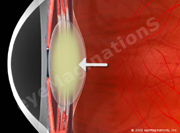Cataracts
Pre-disposing FactorsFamily history is, as with so many other things, a reliable indicator. If your relatives developed cataracts sooner than most people, your chance of doing the same increases. We can't control our genes as yet, so there's not much we can do about this, short of cataract surgery.Diabetes can cause early cataracts, as a direct result of varying blood sugar levels. When the blood sugar is high, the internal lens swells up in response to this, changing the person's glasses prescription. Conversely, low blood sugar leads to lens thinning. This constant swelling and shrinking of the lens disrupts it internally somewhat, causing cloudiness, and clefts of the internal fibres. Cataract SurgeryThankfully, this has become a very much less invasive procedure than say 30 years ago. Today it is normally an outpatient surgery, done under local, not general anaesthesia. Briefly, a small incision is made, 3-4 mm long, under the top lid at the 12 o'clock position on the eye. A small tunnel and flap are created in the sclera (the white of the eye), and a probe is inserted internally into the lens. The lens is broken up into small chunks (by laser, ultrasound or freezing), and removed bit by bit with a vacuum cleaner like instrument. Then, an artificial intra-ocular lens is implanted in place of the cloudy one. This new IOL can be made to whatever power necessary, so the idea is to get people as close to zero for the distance as possible - often distance glasses are much less necessary after a cataract operation. Reading glasses are still required.UV and CataractsOnce the natural UV protection of the body's normal lens is removed, there must be some sort of UV filter incorporated after cataract operations. Now, this is usually put into the lens implant itself, but >15 years ago may not have been. If this is the case, and your IOL does NOT have UV protection built-in, you MUST incorporate this in your eyeware, either glasses or contact lenses.There is some speculation that the increased UV levels we have today due to the hole in the ozone will cause accelerated cataract development in future generations is still unproven. However, UV filters are cheap ($10 to coat your glasses) and the case may be made that "better safe than sorry". |

1701 3rd Ave. E., Owen Sound Map To Office Location |
 |  |

